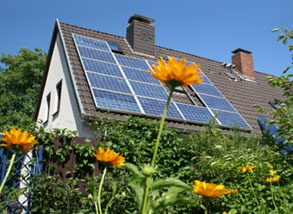Calling it "5 Seismic Shifts" in global power generation, Bloomberg New Energy Finance (BNEF) outlines the dominant trends we’ll see over the next 25 years.
The big news is the scale of renewable energy investment we are about to see, especially in distributed solar energy. The bad news is that without more radical policies, continued fossil fuel emissions will prevent the world from reaching climate goals.
Solar, Solar Everywhere! Costs keep coming down in solar PV, driving a $3.7 trillion surge in solar investment, both large-scale and small-scale.
Power to the People: $2.2 trillion of that will go to rooftop and community-based solar systems, giving individuals and businesses electricity independence by storing it in batteries and giving billions in the developing world access to power for the first time.
Small solar and building-integrated solar will soar from 104 gigawatts in 2014 to nearly 1.8 terawatts in 2040, a 17-fold increase. Prices will drop another 47% per megawatt, conversion efficiencies will improve and the industry will move to new materials and more streamlined production methods.

"Up to now, small-scale solar investment has been dominated by wealthy countries such as Germany, the US and Japan. By 2040, developing economies will have spent $1 trillion on small PV systems, in many cases bringing electricity for the first time to remote villages," says Jenny Chase, chief solar analyst at BNEF.
Utility-scale solar PV will grow 24-fold to 1.9 terawatts, onshore wind will reach 1.8 terawatts (up five-fold) and offshore wind will grow 25 times to 198 gigawatts. Smart grid capacity will grow 17-fold to 858 GW.
By 2030, solar will be the cheapest energy resource and by 2040, the cost of wind projects will have dropped another 32%.
In fact, 78% of the $12.2 trillion invested in power generation will be in emerging markets. Renewables will account for two thirds of that, with $1.6 trillion still in coal, $1.2 trillion in gas and $1.3 trillion in nuclear.
For every 1 GW of new build in the Americas, 3.4 GW will be installed in Asia Pacific nations. China alone will attract $3.3 trillion, nearly double that for the Americas, BNEF says.
Solar Becomes Top Energy Source in 2018
Looking at the shorter term, GTM Research finds 2018 will be the tipping point for solar, when it achieves grid parity worldwide and becomes the energy of choice. By 2020, the world will be installing 135 gigawatts a year, triple the current pace.
The top countries will be China, US and Japan, and Africa, Latin America and the Mid-East will jump from 1% solar today to 17%.
Demand Undershoots: at the same time, ever-increasing energy efficient technologies of all kinds will limit energy demand growth to 1.8% a year, down from 3% a year from 1990-2012. In OECD countries, electricity demand will be lower in 2040 than in 2014.
Gas Flares Briefly: Natural gas will not be the world’s "transition fuel" away from coal, except in the US. Many developing nations will opt for a twin-track of coal and renewables.
Climate Peril: Despite $8 trillion in renewable energy investments, there will still be enough fossil-fuel plants to keep world carbon emissions rising until 2029, and in 2040, emissions will still be 13% above 2014 levels. Fossil fuels will still be used for 44% of electricity production, down from 67% in 2014).
Even with much slower energy demand growth, the world will use 56% more electricity – too much of it from coal – as population and economies expand in developing countries.
"The CO2 content of the atmosphere is on course to exceed 450 parts per million by 2035 even if emissions stay constant, so the trend we show of rising emissions to 2029 makes it very unlikely that the world will be able to limit temperature increases to less than 2 degrees Centigrade," says Seb Henbest, head of Europe, Middle East and Africa for BNEF.
"The message for international negotiators preparing for the Paris climate change conference in December is that current policy settings – even combined with the vast strides renewables are making on competitiveness – will not be enough. Further policy action on emissions will be needed," he adds.
The analysis, however, leaves out key policies that have yet to be put in place, such as EPA’s Clean Power Plan in the US or China’s cap-and-trade systems, which starts official operations next year. In proceeding years, a worldwide cap-and-trade system will likely coalesce.
Read our articles, World Emissions Can – and Must – Peak By 2020 and Stabilizing Our Atmosphere Costs $44 trillion through 2050.
Read BNEF’s report, New Energy Outlook 2015:
